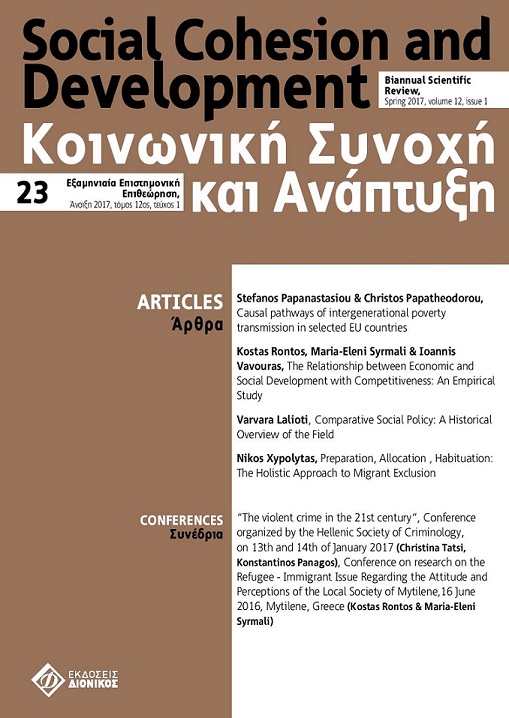H επίδραση της εκπαίδευσης στο εισόδημα μεταξύ δύο γενεών σε κράτη πρόνοιας της ΕΕ

Περίληψη
Αξιοποιώντας μικροδεδομένα της EU-SILC του 2011 και χρησιμοποιώντας τεχνικές παλινδρόμησης σε τέσσερα κράτη πρόνοιας της ΕΕ (δηλ. Ελλάδα, Γαλλία, Ιρλανδία και Σουηδία), το άρθρο αυτό καταδεικνύει τη μειούμενη επίδραση της εκπαίδευσης στα εισοδηματικά επιτεύγματα μεταξύ δύο γενεών. Το εύρημα αυτό θέτει υπό αμφισβήτηση το κύριο επιχείρημα του κυρίαρχου ακαδημαϊκού και πολιτικού λόγου γύρω από τον πρωτεύοντα ρόλο της εκπαίδευσης για την άντληση εισοδήματος. Αντίθετα, το άρθρο αυτό τονίζει τη σημασία άλλων παραγόντων για την ερμηνεία των εισοδηματικών επιτευγμάτων, όπως η κοινωνική διασυνδεσιμότητα. Η τελευταία μπορεί να παράγει ή να αναπαράγει την ανισότητα εφόσον τα άτομα αποκτούν πρόσβαση σε ισχυρές θέσεις μέσω της χρήσης των κοινωνικών συνδέσεων. Έτσι, οι ανώτερες κοινωνικές τάξεις με εκτεταμένη κοινωνική δικτύωση διατηρούν τα κοινωνικά προνόμια μεταξύ των γενεών παρά το επιχείρημα ότι η σύγχρονη κοινωνία επιδεικνύει υψηλή κοινωνική κινητικότητα που επιτυγχάνεται μέσω της επίσημης εκπαίδευσης.
Λεπτομέρειες άρθρου
- Πώς να δημιουργήσετε Αναφορές
-
Papanastasiou, S. (2018). H επίδραση της εκπαίδευσης στο εισόδημα μεταξύ δύο γενεών σε κράτη πρόνοιας της ΕΕ. Κοινωνική Συνοχή και Ανάπτυξη, 12(2), 101–113. https://doi.org/10.12681/scad.18957
- Τεύχος
- Τόμ. 12 Αρ. 2 (2017)
- Ενότητα
- Άρθρα

Αυτή η εργασία είναι αδειοδοτημένη υπό το CC Αναφορά Δημιουργού – Μη Εμπορική Χρήση – Παρόμοια Διανομή 4.0.
Οι συγγραφείς των άρθρων που δημοσιεύονται στην Κοινωνική Συνοχή και Ανάπτυξη διατηρούν τα δικαιώματα πνευματικής ιδιοκτησίας επί των άρθρων τους, δίνοντας στο περιοδικό το δικαίωμα της πρώτης δημοσίευσης. Άρθρα που δημοσιεύονται στην Κοινωνική Συνοχή διατίθενται με άδεια Creative Commons 4.0 και σύμφωνα με την άδεια μπορούν να χρησιμοποιούνται ελεύθερα, με αναφορά στο/στη συγγραφέα και στην πρώτη δημοσίευση για μη κερδοσκοπικούς σκοπούς και με δικαίωμα τροποποίησης μόνον με παρόμοια διανομή (αν αναμείξετε, τροποποιήσετε, ή δημιουργήσετε πάνω στο υλικό, πρέπει να διανείμετε τις δικές σας συνεισφορές υπό την ίδια άδεια όπως και το πρωτότυπο).



